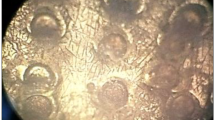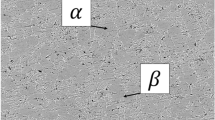Abstract
Precise control of friction and wear is very important for energy efficiency and sustainability in manufacturing processes. In this research, different kinds of surface textures have been created on steel surfaces to vary the frictional conditions at the interface. The surface textures were varied from unidirectional pattern to criss-cross pattern by rubbing the steel surfaces under dry conditions against different grits of emery papers for various numbers of cycles. The sliding experiments were conducted at a velocity of 2 mm/s using an inclined pin-on-plate apparatus with Al–Mg alloy pins against steel plate surfaces of different textures with roughness under dry and lubricated conditions at ambient conditions. Results showed that the coefficient of friction (COF) and transfer layer formation on the plate surfaces were controlled by the surface textures of the steel materials under both dry and lubricated conditions. Analyzing the surfaces in terms of various roughness parameters, it was found that the asperity angle of the steel surface played a key role in controlling the COF and transfer layer during sliding. The friction and wear performance can be accurately controlled by creating appropriate surface textures and understanding their surface roughness parameters in order to enhance energy efficiency and the quality of finished products in manufacturing processes.
Similar content being viewed by others
References
Menezes PL, Kailas SV, Lovell MR (2013) Fundamentals of engineering surfaces. In: Menezes PL, Nosonovsky M, Ingole SP, Kailas SV, Lovell MR (eds) Tribology for scientists and engineers. Springer, New York, pp 3–41
Menezes PL, Nosonovsky M, Kailas SV, Lovell MR (2013) Friction and wear. In: Menezes PL, Nosonovsky M, Ingole SP, Kailas SV, Lovell MR (eds) Tribology for scientists and engineers. Springer, New York, pp 43–91
Menezes PL, Reeves C, Kailas SV, Lovell MR (2013) Tribology in metal forming. In: Menezes PL, Nosonovsky M, Ingole SP, Kailas SV, Lovell MR (eds) Tribology for scientists and engineers. Springer, New York, pp 783–818
Hawkyard JB, Johnson W (1967) An analysis of the changes in geometry of a short hollow cylinder during axial compression. Int J Mech Sci 9:163–182
Robinson T, Ou H, Armstrong CG (2004) Study on ring compression test using physical modelling and FE simulation. J Mater Process Technol 153–154:54–59
Xu WL, Rao KP (1997) Analysis of the deformation characteristics of spike-forging process through FE simulations and experiments. J Mater Process Technol 70:122–128
Wang XW, Zhu XH (1995) Numerical simulation of deep-drawing process. J Mater Process Technol 48:123–127
Wang Z, Lu J, Wang ZR (2001) Numerical and experimental research of the cold upsetting–extruding of tube flanges. J Mater Process Technol 110:28–35
Lazzarotto L, Dubar L, Dubois A, Ravassard P, Oudin J (1997) Identification of Coulomb’s friction coefficient in real contact conditions applied to a wire drawing process. Wear 211:54–63
Menezes PL, Kishore, Kailas SV, Lovell M (2015) Influence of surface texture and roughness of softer and harder counter materials on friction during sliding. J Mater Eng Perform 24:393–403
Wagner S (2001) Optimizing friction between die and sheet metal. In proceedings of second global symposium on innovations in materials, Processing and manufacturing, TMS, New Orleans, February 12-15, United States, p 245–267
Bello DO, Walton S (1987) Surface topography and lubrication in sheet-metal forming. Tribol Int 20:59–65
Schedin E (1994) Galling mechanisms in sheet forming operations. Wear 179:123–128
Barber GC, Gao H, Tung SC (2005) Experimental study on the friction characteristics of lasertex steel sheets during metal forming process. Tribol Trans 48:245–249
Rasp W, Wichern CM (2002) Effects of surface-topography directionality and lubrication condition on frictional behaviour during plastic deformation. J Mater Process Technol 125–126:379–386
Saha PK, Wilson WRD, Timsit RS (1996) Influence of surface topography on the frictional characteristics of 3104 aluminum alloy sheet. Wear 197:123–129
Wihlborg A, Crafoord R (2001) Steel sheet surface topography and its influence on friction in a bending under tension friction test. Int J Mach Tools Manuf 41:1953–1959
Kumar CP, Menezes PL, Kailas SV (2008) Role of surface texture on friction under boundary lubricated conditions. Tribol Online 3:12–18
Costa HL, Hutchings IM (2009) Effects of die surface patterning on lubrication in strip drawing. J Mater Process Technol 209:1175–1180
Malayappan S, Narayanasamy R (2004) An experimental analysis of upset forging of aluminium cylindrical billets considering the dissimilar frictional conditions at flat die surfaces. Int J Adv Manuf Technol 23:636–643
Määttä A, Vuoristo P, Mäntylä T (2001) Friction and adhesion of stainless steel strip against tool steels in unlubricated sliding with high contact load. Tribol Int 34:779–786
Hu ZM, Dean TA (2000) A study of surface topography, friction and lubricants in metal forming. Int J Mach Tools Manuf 40:1637–1649
Lakshmipathy R, Sagar R (1992) Effect of die surface topography on die-work interfacial friction in open die forging. Int J Mach Tools Manuf 32:685–693
Staph HE, Ku PM, Carper HJ (1973) Effect of surface roughness and surface texture on scuffing. Mech Mach Theory 8:197–208
Koura MM (1980) The effect of surface texture on friction mechanisms. Wear 63:1–12
Wakuda M, Yamauchi Y, Kanzaki S, Yasuda Y (2003) Effect of surface texturing on friction reduction between ceramic and steel materials under lubricated sliding contact. Wear 254:356–363
Xie Y, Williams JA (1996) The prediction of friction and wear when a soft surface slides against a harder rough surface. Wear 196:21–34
Pottirayil A, Menezes PL, Kailas SV (2010) A parameter characterizing plowing nature of surfaces close to Gaussian. Tribol Int 43:370–380
Menezes PL, Kishore, Kailas SV (2008) Influence of roughness parameters on coefficient of friction under lubricated conditions. Sadhana 33:181–190
Sedlaček M, Podgornik B, Vižintin J (2009) Influence of surface preparation on roughness parameters, friction and wear. Wear 266:482–487
Myers NO (1962) Characterization of surface roughness. Wear 5:182–189
Wieleba W (2002) The statistical correlation of the coefficient of friction and wear rate of PTFE composites with steel counterface roughness and hardness. Wear 252:719–729
Singh R, Melkote SN, Hashimoto F (2005) Frictional response of precision finished surfaces in pure sliding. Wear 258:1500–1509
Menezes PL, Kishore, Kailas SV (2009) Study of friction and transfer layer formation in copper-steel tribo-system: role of surface texture and roughness parameters. Tribol Trans 52:611–622
Menezes PL, Kishore, Kailas SV (2009) Influence of roughness parameters and surface texture on friction during sliding of pure lead over 080 M40 steel. Int J Adv Manuf Technol 43:731–743
Menezes PL, Kishore, Kailas SV, Lovell MR (2010) Response of materials as a function of grinding angle on friction and transfer layer formation. Int J Adv Manuf Technol 49:485–495
Gadelmawla ES, Koura MM, Maksoud TMA, Elewa IM, Soliman HH (2002) Roughness parameters. J Mater Process Technol 123:133–145
Koura MM, Omar MA (1981) The effect of surface parameters on friction. Wear 73:235–246
Torrance AA (1995) Using profilometry for the quantitative assessment of tribological function: PC-based software for friction and wear prediction. Wear 181–183:397–404
Menezes PL, Kishore, Kailas SV, Lovell MR (2011) Friction and transfer layer formation in polymer–steel tribo-system: role of surface texture and roughness parameters. Wear 271:2213–2221
Black AJ, Kopalinsky EM, Oxley PLB (1988) An investigation of the different regimes of deformation which can occur when a hard wedge slides over a soft surface: the influence of wedge angle, lubrication and prior plastic working of the surface. Wear 123:97–114
Challen JM, Oxley PLB (1979) An explanation of the different regimes of friction and wear using asperity deformation models. Wear 53:229–243
Author information
Authors and Affiliations
Corresponding author
Rights and permissions
About this article
Cite this article
Menezes, P.L. Surface texturing to control friction and wear for energy efficiency and sustainability. Int J Adv Manuf Technol 85, 1385–1394 (2016). https://doi.org/10.1007/s00170-015-8058-2
Received:
Accepted:
Published:
Issue Date:
DOI: https://doi.org/10.1007/s00170-015-8058-2




